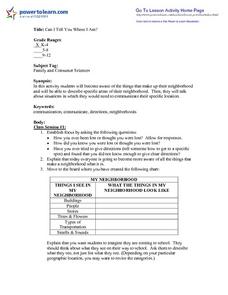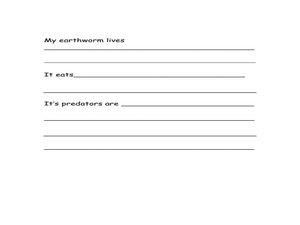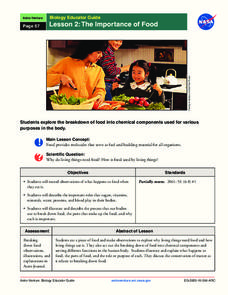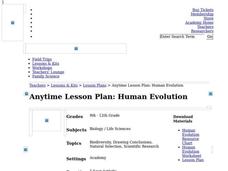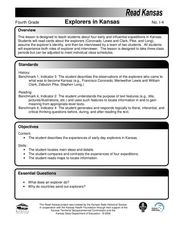Curated OER
Comparing Seeds
Students explore the process of growing plants from seeds. In this hands-on science experiment, students observe different seeds (store bought vs. those directly from food items) and predict growing patterns.
Curated OER
Vocabulary Builder- Using Inspiration to Generate Lists of Descriptive Words
Students discover how to engage all their senses and powers of observation to effectively communicate and idea or emotion. Using Inspiration Software, they create a vocabulary web and practice using descriptive language to clarify and...
Curated OER
Copycats
Students practice making prints of their own unique designs. In this printmaking lesson, students create a design with paint on Styrofoam plates. They press their painted picture on paper to create a duplicate print. They then practice...
Curated OER
Can I Tell You Where I am?
Students participate in a lesson that is concerned with the factors of describing a neighborhood. They follow a set of target questions in order to obtain information about individual neighborhoods. The information is used The write...
Curated OER
Earthworms and Making a Wormery
Students explore the environment by researching insects. In this earthworm lesson, students utilize soil and plexiglass to build a see through wormery in which students can observe the worms at work. Students identify the benefits of...
Curated OER
Historical Witness Social Messaging Beginning Level Activity
Young scholars explore women in history. In this activity about nineteenth century women, students analyze paintings looking at women and their clothing, expressions, body language, and the setting and color. Young scholars understand...
Curated OER
Sprouting Sprouts!
Learners plant sprout seeds and make observations. In this lesson about planting, students make observations, predictions, and record information. Learners analyze how the sprout plants grow and determine if any of the four sprout seeds...
NASA
The Importance of Food
Pupils make observations while eating food. They act out the process of food breaking down in the body and the roles of various chemical components, such as sugar and protein. It concludes with an activity illustrating the process and a...
Curated OER
Genetics Survey Project
Complete a survey on genetics and the mechanics of heredity.and review the list of human traits observed. Practice interviews are conducted with each other so that noone feels unconformable if they don't have one trait or another. One...
Curated OER
The Big Squeeze
Students observe what happens as crayon shavings are melted and/or pressed together. They compare this to the process some rocks go through as they are heated and compressed naturally on earth.
California Academy of Science
Human Evolution
As the great and hilarious Tim Minchin once said, "Science is simply the word we use to describe a method of organizing our curiosity." Science is more than just a guess; it is based on questions, observations, and evidence. High...
Towson University
Looking Into Lactase: Guided Inquiry
Milk does a body good ... unless, of course, someone is lactose intolerant. Pupils play the role of pharmaceutical scientists in a guided inquiry lab about lactase. Lab groups collaborate to learn more about lactose intolerance, how...
Curated OER
How Big Is That Star?
Aspiring astronomers study stars. They compare stars and explain the relationship between radius, mass, and diameter. By creating a star simulation, they discover how a binary star system's orbit can cause changes in the observed...
Curated OER
Explorers in Kansas
Fourth graders read cards about the explorers: Coronado, Lewis, and Clark, Pike, and Long. In this influential expeditions lesson, 4th graders describe and observe explorers who came to Kansas. Students locate main reasons and details as...
Discovery Education
The Everyday Science of Sports
Physical science juniors will enjoy this sensational enrichment on aerodynamics, especially if they are also sports fans! With a focus on physical features and behaviors, collaborative groups make observations on five different golf...
Curated OER
Revive, Contemplate, Integrate
Students recognize flags as a symbol through writing and imagery. In this artifact lesson plan, students investigate Tibetan prayer flags and their significance. Students create personal prayer flags and write about their life experience...
California Academy of Science
Colorful Fish Adaptations
I love lessons that incorporate the arts, they're so engaging and address a more diverse set of learners. Your class will investigate the reasons fish from the coal reef have adapted such colorful fins. They design a fish that uses color...
American Chemical Society
Can Gases Dissolve in Water?
Why does soda fizz when opened? Learners discuss the appearance of bubbles in soda bottles when opened. In groups, they design and complete an experiment comparing the amount of carbon dioxide dissolving in cold versus hot liquids.
Curated OER
Read All About It! California History of the 30s and 40s
Explore the Great Depression! Discover the challenges people experienced during the time period. Learners investigate photographs from the Dust Bowl and WWII era and create a story line about the photographs, writing a newspaper article...
Curated OER
Using Your Senses
Here is a terrific lesson that uses a special State Quarter as a learning tool. This one uses the Alabama State Quarter. During this lesson, pupils learn about their five senses. They make observations about what is in paper bags using...
NASA
Stellar Fingerprints and Doppler Red Shifts
Young scientists observe the spectra of elements and compare that to the Doppler effect. Hook scholars from the beginning all the way to the extension activities in this 5E-format lesson.
Royal Society of Chemistry
Acids and Bases—Microscale Chemistry
Here's proof that small-scale labs lead to big-time learning. Introduce acid-base interactions to middle school scientists through a microscale chemistry lab. Pupils combine a variety of solutions and use indicators to obtain approximate...
Curated OER
Reading Our Neighborhood
Young scholars explore their environment and what they can read. In this instructional activity about signs, letters, and pictures in the neighborhood, students will observe what they see around them. Young scholars walk around and take...
Curated OER
Variation
Students recognize similarities and differences in plants. In this plants and animals lesson, students begin to classify living things by observable characteristics. Students watch clips from the Internet and play online games. Students...





